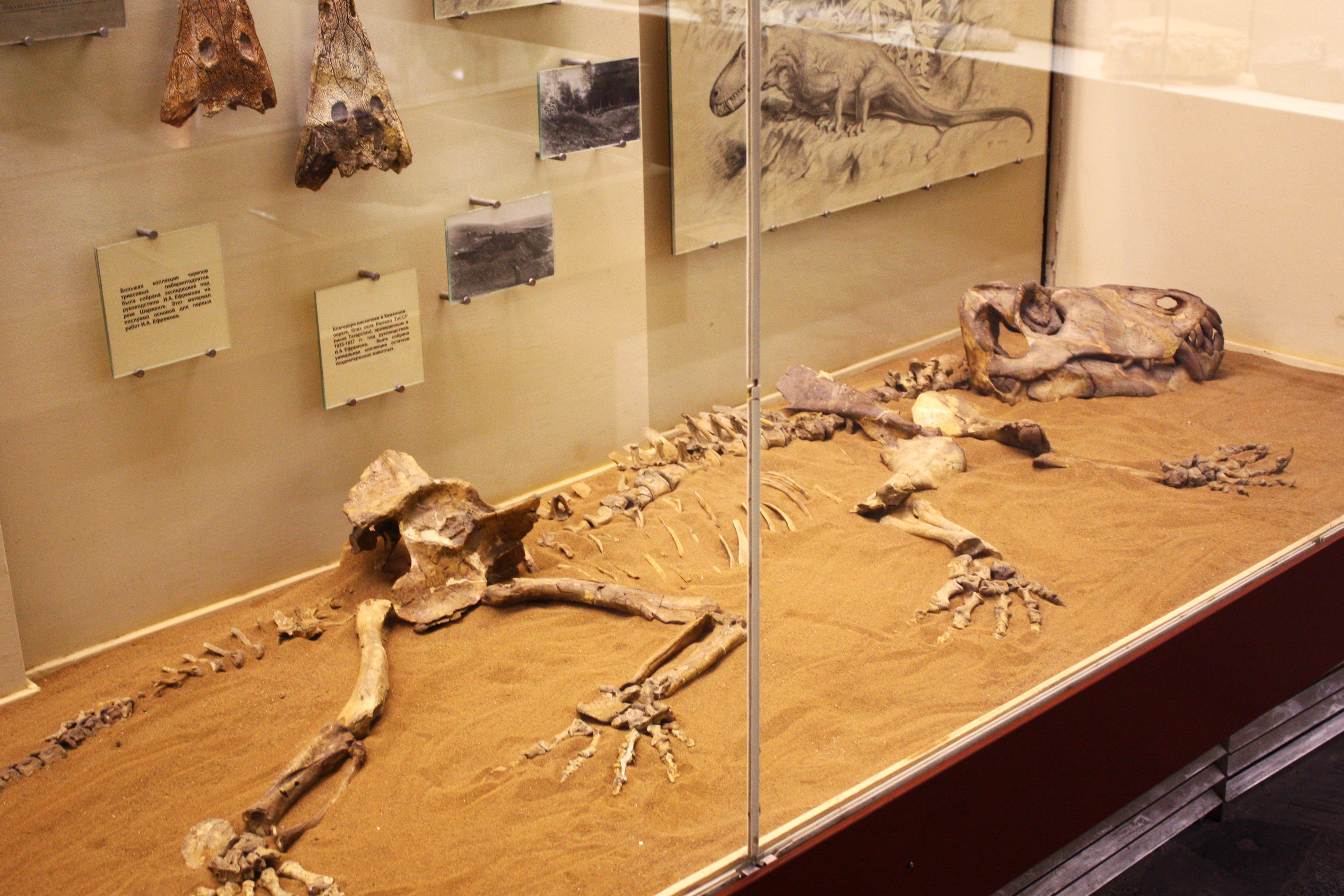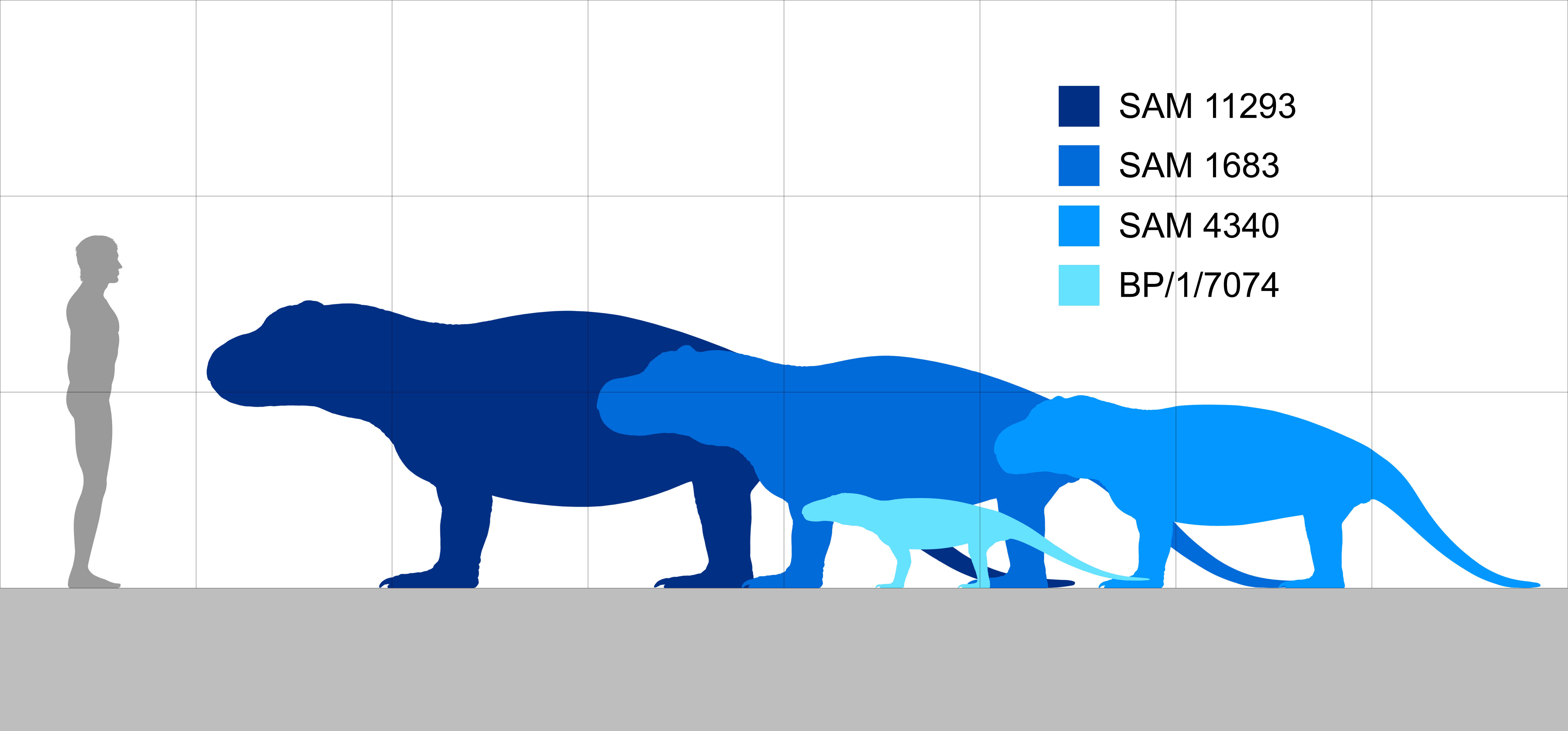|
Anteosaurs
Anteosaurs are a group of large, primitive carnivorous dinocephalian therapsids with large canines and incisors and short limbs, that are known from the Middle Permian of South Africa, Russia, China, and Brazil. Some grew very large, with skulls long, and were the largest predators of their time. They died out at the end of the Middle Permian, possibly as a result of the extinction of the herbivorous Tapinocephalia on which they may have fed. Description The Anteosauria are distinguished from the Tapinocephalia by a number of features, such as very large canines, cheek teeth with bulbous crowns, and an upturning of the premaxilla, so that the front of mouth curves strongly upwards. There is a tendency especially in more advanced forms such as ''Anteosaurus'' towards thickening of the bones of the top of the skull, indicating head-butting behaviour. There is a large canal for the pineal organ (third eye); probably tied in with the animal's diurnal and seasonal cycles. The shoul ... [...More Info...] [...Related Items...] OR: [Wikipedia] [Google] [Baidu] |
Anteosaurus
''Anteosaurus'' (meaning "Antaeus reptile") is an extinct genus of large carnivorous dinocephalian synapsid. It lived at the end of the Guadalupian (= Middle Permian) during the Capitanian stage, about 265 to 260 million years ago in what is now South Africa. It is mainly known by cranial remains and few postcranial bones. With its skull reaching in length and a body size estimated at more than in length, and in weight, ''Anteosaurus'' was the largest known carnivorous non-mammalian synapsid and the largest terrestrial predator of the Permian period. Occupying the top of the food chain in the Middle Permian, its skull, jaws and teeth show adaptations to capture large prey like the giants titanosuchids and tapinocephalids dinocephalians and large pareiasaurs. As in many other dinocephalians the cranial bones of ''Anteosaurus'' are pachyostosed, but to a lesser extent than in tapinocephalid dinocephalians. In ''Anteosaurus'', pachyostosis mainly occurs in the form of horn-sha ... [...More Info...] [...Related Items...] OR: [Wikipedia] [Google] [Baidu] |
Archaeosyodon DB
''Archaeosyodon'' is an extinct genus of dinocephalian therapsids. It was medium-sized, reaching about 1.5–2 m (4–5 ft) in length. See also * List of therapsids This list of therapsids is an attempt to create a comprehensive listing of all genera that have ever been included in the Therapsida excluding mammals and purely vernacular terms. The list includes all commonly accepted genera, but also genera tha ... References Anteosaurs Prehistoric therapsid genera Permian synapsids of Asia Prehistoric synapsids of Europe Guadalupian synapsids Fossil taxa described in 1960 Guadalupian genus first appearances Guadalupian genus extinctions {{paleo-therapsid-stub ... [...More Info...] [...Related Items...] OR: [Wikipedia] [Google] [Baidu] |
Titanophoneus
''Titanophoneus'' ("titanic murderer") is an extinct genus of carnivorous dinocephalian therapsid from the Middle Permian. It is classified within the family Anteosauridae. The type species is ''Titanophoneus potens''. Remains of ''Titanophoneus'' have been found at Isheevo in Russia. Description An adult skull would have reached 80 cm with a heavy long snout. The long tail and short limbs show the species to be a primitive therapsid unlike '' Inostrancevia'' which was more advanced. The structure of the limbs and the density of the bone are designed for a sprawling stance. The temporal opening is more advanced than Estemmenosuchidae but less advanced than ''Inostrancevia''. The teeth are large with 12 large palate incisors followed by 2 canines and various smaller back teeth. The lower palate is the same as the upper but without the canine teeth. The appearance of ''Titanophoneus'' is reminiscent to the sphenacodontid pelycosaurs, which included ''Dimetrodon''. Gallery im ... [...More Info...] [...Related Items...] OR: [Wikipedia] [Google] [Baidu] |
Titanophoneus Moscow
''Titanophoneus'' ("titanic murderer") is an extinct genus of carnivorous dinocephalian therapsid from the Middle Permian. It is classified within the family Anteosauridae. The type species is ''Titanophoneus potens''. Remains of ''Titanophoneus'' have been found at Isheevo in Russia. Description An adult skull would have reached 80 cm with a heavy long snout. The long tail and short limbs show the species to be a primitive therapsid unlike ''Inostrancevia'' which was more advanced. The structure of the limbs and the density of the bone are designed for a sprawling stance. The temporal opening is more advanced than Estemmenosuchidae but less advanced than ''Inostrancevia''. The teeth are large with 12 large palate incisors followed by 2 canines and various smaller back teeth. The lower palate is the same as the upper but without the canine teeth. The appearance of ''Titanophoneus'' is reminiscent to the sphenacodontid pelycosaurs, which included ''Dimetrodon''. Gallery imag ... [...More Info...] [...Related Items...] OR: [Wikipedia] [Google] [Baidu] |
Anteosaurus Magnificus BW Lateral
''Anteosaurus'' (meaning "Antaeus reptile") is an extinct genus of large carnivorous dinocephalian synapsid. It lived at the end of the Guadalupian (= Middle Permian) during the Capitanian stage, about 265 to 260 million years ago in what is now South Africa. It is mainly known by cranial remains and few postcranial bones. With its skull reaching in length and a body size estimated at more than in length, and in weight, ''Anteosaurus'' was the largest known carnivorous non-mammalian synapsid and the largest terrestrial predator of the Permian period. Occupying the top of the food chain in the Middle Permian, its skull, jaws and teeth show adaptations to capture large prey like the giants titanosuchids and tapinocephalids dinocephalians and large pareiasaurs. As in many other dinocephalians the cranial bones of ''Anteosaurus'' are pachyostosed, but to a lesser extent than in tapinocephalid dinocephalians. In ''Anteosaurus'', pachyostosis mainly occurs in the form of horn-sha ... [...More Info...] [...Related Items...] OR: [Wikipedia] [Google] [Baidu] |
Goat
The goat or domestic goat (''Capra hircus'') is a domesticated species of goat-antelope typically kept as livestock. It was domesticated from the wild goat (''C. aegagrus'') of Southwest Asia and Eastern Europe. The goat is a member of the animal family Bovidae and the tribe Caprini, meaning it is closely related to the sheep. There are over 300 distinct breeds of goat.Hirst, K. Kris"The History of the Domestication of Goats".''About.com''. Accessed August 18, 2008. It is one of the oldest domesticated species of animal, according to archaeological evidence that its earliest domestication occurred in Iran at 10,000 calibrated calendar years ago. Goats have been used for milk, meat, fur, and skins across much of the world. Milk from goats is often turned into goat cheese. Female goats are referred to as ''does'' or ''nannies'', intact males are called ''bucks'' or ''billies'', and juvenile goats of both sexes are called ''kids''. Castrated males are called ''wethers''. Whil ... [...More Info...] [...Related Items...] OR: [Wikipedia] [Google] [Baidu] |
Pachycephalosauria
Pachycephalosauria (; from Greek παχυκεφαλόσαυρος for 'thick headed lizards') is a clade of ornithischian dinosaurs. Along with Ceratopsia, it makes up the clade Marginocephalia. With the exception of two species, most pachycephalosaurs lived during the Late Cretaceous Period, dating between about 85.8 and 65.5 million years ago. They are exclusive to the Northern Hemisphere, all of them being found in North America and Asia. They were all bipedal, herbivorous/omnivorous animals with thick skulls. Skulls can be domed, flat, or wedge-shaped depending on the species, and are all heavily ossified. The domes were often surrounded by nodes and/or spikes. Partial skeletons have been found of several pachycephalosaur species, but to date no complete skeletons have been discovered. Often isolated skull fragments are the only bones that are found. Candidates for the earliest known pachycephalosaur include ''Ferganocephale adenticulatum'' from Middle Jurassic Period strata ... [...More Info...] [...Related Items...] OR: [Wikipedia] [Google] [Baidu] |
Dinosaurs
Dinosaurs are a diverse group of reptiles of the clade Dinosauria. They first appeared during the Triassic period, between 243 and 233.23 million years ago (mya), although the exact origin and timing of the evolution of dinosaurs is the subject of active research. They became the dominant terrestrial vertebrates after the Triassic–Jurassic extinction event 201.3 mya; their dominance continued throughout the Jurassic and Cretaceous periods. The fossil record shows that birds are feathered dinosaurs, having evolved from earlier theropods during the Late Jurassic epoch, and are the only dinosaur lineage known to have survived the Cretaceous–Paleogene extinction event approximately 66 mya. Dinosaurs can therefore be divided into avian dinosaurs—birds—and the extinct non-avian dinosaurs, which are all dinosaurs other than birds. Dinosaurs are varied from taxonomic, morphological and ecological standpoints. Birds, at over 10,700 living species, are among ... [...More Info...] [...Related Items...] OR: [Wikipedia] [Google] [Baidu] |
Titanothere
Brontotheriidae is a family (biology), family of extinct mammals belonging to the order Perissodactyla, the order that includes horses, rhinoceroses, and tapirs. Superficially, they looked rather like Rhinoceros, rhinos, although they were actually more closely related to horses; Equidae and Brontotheriidae make up the suborder Hippomorpha. They lived around 56–34 million years ago, until the very close of the Eocene. Characteristics and evolution Brontotheres retain four toes on their front feet and three toes on their hind feet. Their teeth are adapted to shearing (cutting) relatively nonabrasive vegetation. Their molar (tooth), molars have a characteristic W-shaped ectoloph (outer shearing blade). The evolutionary history of this group is well known due to an excellent fossil record in North America. The earliest brontotheres, such as ''Eotitanops'', were rather small, no more than a meter in height, and hornless. Brontotheres evolved massive bodies, although some small ... [...More Info...] [...Related Items...] OR: [Wikipedia] [Google] [Baidu] |
Middle Permian
The Guadalupian is the second and middle series/epoch of the Permian. The Guadalupian was preceded by the Cisuralian and followed by the Lopingian. It is named after the Guadalupe Mountains of New Mexico and Texas, and dates between 272.95 ± 0.5 – 259.1 ± 0.4 Mya. The series saw the rise of the therapsids, a minor extinction event called Olson's Extinction and a significant mass extinction called the end-Capitanian extinction event. The Guadalupian was previously known as the Middle Permian. Name and background The Guadalupian is the second and middle series or epoch of the Permian. Previously called Middle Permian, the name of this epoch is part of a revision of Permian stratigraphy for standard global correlation. The name "Guadalupian" was first proposed in the early 1900s, and approved by the International Subcommission on Permian Stratigraphy in 1996. References to the Middle Permian still exist. The Guadalupian was preceded by the Cisuralian and followed by the Lop ... [...More Info...] [...Related Items...] OR: [Wikipedia] [Google] [Baidu] |
Pareiasaur
Pareiasaurs (meaning "cheek lizards") are an extinct clade of large, herbivorous parareptiles. Members of the group were armoured with scutes which covered large areas of the body. They first appeared in southern Pangea during the Middle Permian, before becoming globally distributed during the Late Permian. Pareiasaurs were the largest reptiles of the Permian, reaching sizes equivalent to those of contemporary therapsids. Pareiasaurs became extinct at the end of the Permian during the Permian-Triassic extinction event. Description Pareiasaurs ranged in size from long, and may have weighed up to . They were stocky, with short tails, small heads, robust limbs, and broad feet. The cow-sized species '' Bunostegos'', which lived 260 million years ago, is the earliest known example of a tetrapod with a fully erect posture as its legs were positioned directly under its body. Pareiasaurs were protected by bony scutes called osteoderms that were set into the skin. Their heavy skulls wer ... [...More Info...] [...Related Items...] OR: [Wikipedia] [Google] [Baidu] |







